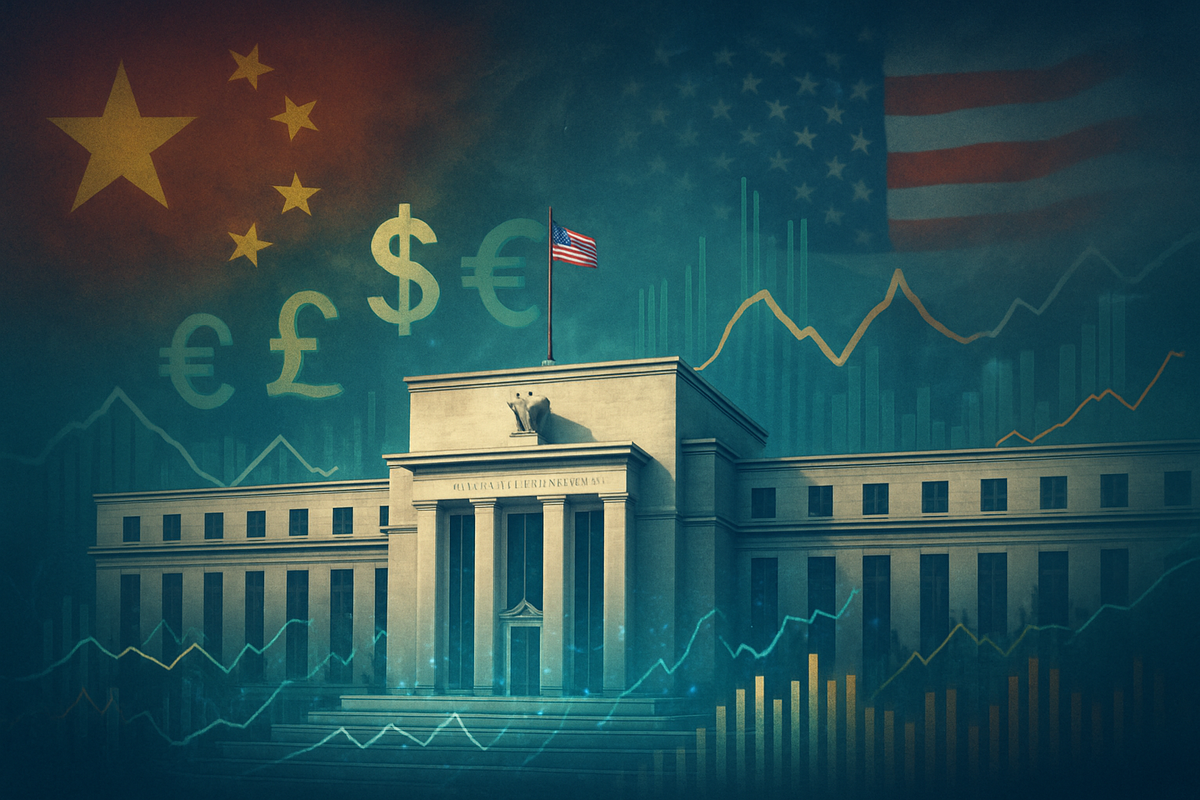
As October 2025 draws to a close, financial markets are bracing for another pivotal moment from the Federal Reserve. Following a 25-basis-point reduction in September, the Federal Open Market Committee (FOMC) is widely expected to enact a further quarter-point rate cut at its meeting scheduled for October 28-29. This anticipated move, which would lower the federal funds rate target range to 3.75%-4.00%, signals a strategic pivot by the U.S. central bank, prioritizing labor market stability amidst emerging signs of economic softening, even as inflation remains a persistent concern. The ramifications of such a decision are poised to ripple across foreign exchange markets, recalibrating currency valuations, and reshaping the U.S. Treasury yield curve.
The implications for global finance are immediate and multifaceted. A weaker U.S. dollar, typically a direct consequence of lower interest rates, could provide a tailwind for commodity-linked currencies and emerging market assets, while potentially easing pressure on countries holding dollar-denominated debt. Simultaneously, the bond market faces a complex repricing, with short-term yields expected to decline, yet long-term Treasury yields potentially exhibiting a more nuanced, even upward, trajectory due to underlying inflation expectations and fiscal dynamics. Adding another layer of complexity to this financial tableau are the ongoing, high-stakes U.S.-China trade talks, which continue to inject policy uncertainty and volatility into an already sensitive global economic environment.
The Fed's Dovish Turn: Navigating a Shifting Economic Tide
The Federal Reserve's anticipated interest rate cut in October 2025 is not an isolated event but rather a continuation of a cautious easing cycle initiated in September. The primary catalyst for this dovish shift is a growing concern within the FOMC regarding the health of the U.S. labor market. Recent economic indicators, including a slowdown in job growth, an uptick in initial unemployment claims, and an increase in long-term unemployment, have signaled a potential weakening that the Fed is keen to address preemptively. Despite the Consumer Price Index (CPI) showing a slightly lower-than-expected rise in September, persistent inflationary pressures, partly exacerbated by ongoing tariffs, remain a backdrop to the Fed's employment mandate. The central bank's current stance suggests a prioritization of employment stability to avert a more significant economic downturn.
Market participants, as reflected by the CME Group's FedWatch tool, are pricing in a 97% probability of this 25-basis-point reduction, suggesting it is largely factored into current asset prices. This consensus view underscores the clarity of the Fed's communication and the market's interpretation of economic data. Key players involved in this decision-making process include Federal Reserve Chair Jerome Powell, who has consistently emphasized a data-dependent approach, and the broader FOMC, whose members weigh various economic indicators and forecasts. Economists widely agree that the cumulative effect of these rate cuts is intended to lower borrowing costs across the economy, thereby stimulating investment, consumption, and ultimately, job creation. However, the initial market reaction to the September cut, particularly the modest rise in 10-year Treasury yields, highlights the complexity of disentangling monetary policy from other influential market forces.
Corporate Fortunes: Winners and Losers in a Lower Rate Environment
A Federal Reserve rate cut, particularly when signaling a more accommodative monetary policy, invariably creates a distinct set of winners and losers across various industries and public companies. The immediate beneficiaries are often sectors that are highly sensitive to interest rates or benefit from a weaker U.S. dollar.
Potential Winners:
- Housing and Real Estate: Companies involved in homebuilding like D.R. Horton (NYSE: DHI) and Lennar Corporation (NYSE: LEN), as well as real estate investment trusts (REITs) such as Simon Property Group (NYSE: SPG), typically benefit from lower mortgage rates, which make housing more affordable and stimulate demand. Lower borrowing costs can also improve the profitability of property development.
- Exporters: A weaker U.S. dollar makes American goods and services more competitive on the global market. Large multinational corporations with significant international sales, such as Boeing (NYSE: BA) in aerospace, Apple (NASDAQ: AAPL) in technology, and Caterpillar (NYSE: CAT) in industrial machinery, could see increased demand and improved repatriated earnings.
- Borrowers and High-Growth Tech: Companies with substantial debt or those reliant on venture capital and cheap financing for growth, particularly in the technology sector, stand to gain. Lower interest rates reduce debt servicing costs and can make future borrowing more attractive for expansion. Companies like Amazon (NASDAQ: AMZN) and Tesla (NASDAQ: TSLA), which often fund ambitious projects, could see their cost of capital decrease.
- Emerging Markets and Commodity Producers: A weaker dollar generally translates to stronger commodity prices (as commodities are dollar-denominated) and improved capital flows into emerging markets. This could benefit companies in resource-rich nations and those operating in developing economies.
Potential Losers:
- Banks and Financial Institutions: While lower rates can stimulate borrowing, a compressed net interest margin (NIM) – the difference between what banks earn on loans and pay on deposits – can negatively impact profitability. Major banks like JPMorgan Chase (NYSE: JPM), Bank of America (NYSE: BAC), and Wells Fargo (NYSE: WFC) might face headwinds on their core lending business, though increased loan volumes could partially offset this.
- Savers and Fixed Income Investors: Individuals and institutions relying on interest income from savings accounts, Certificates of Deposit (CDs), and certain money market funds will see their returns diminish. This can shift investment behavior towards riskier assets in search of yield.
- Importers: Conversely to exporters, a weaker dollar makes imported goods more expensive. Retailers heavily reliant on imported inventory, such as Walmart (NYSE: WMT) or Target (NYSE: TGT), could face higher input costs, potentially squeezing profit margins or leading to higher consumer prices.
- Companies with Strong Dollar Exposure (Negative): U.S. companies that generate a significant portion of their revenue overseas but report in dollars might see their foreign earnings diminish when converted back to a weaker dollar.
The overall impact on these companies will depend on their specific business models, debt structures, geographic revenue exposure, and hedging strategies. However, the general direction of a rate cut points towards a rebalancing of financial flows and corporate profitability.
Broader Implications: Navigating Macroeconomic Currents and Geopolitical Headwinds
The Federal Reserve's expected rate cut in October 2025 transcends immediate market reactions, fitting into a broader narrative of evolving macroeconomic trends and significant geopolitical undercurrents. This move underscores the Fed's delicate balancing act between its dual mandate of maximizing employment and maintaining price stability. While inflation, partly fueled by ongoing tariffs, remains above target, the central bank's pivot towards easing signals a greater concern for the deteriorating health of the labor market. This prioritization reflects a proactive stance to prevent a more severe economic contraction, echoing historical periods where the Fed intervened to support growth.
Historically, periods of Fed easing have often been associated with a weakening dollar and a steepening of the yield curve, where long-term rates rise relative to short-term rates. However, the current environment presents unique complexities. The persistence of inflation, coupled with increasing fiscal deficits and investor demands for a higher "term premium" for holding longer-dated bonds, suggests that long-term Treasury yields, such as the 10-year, might not fall significantly, or could even rise, creating a less predictable bond market landscape. This divergence between short and long-term rates could impact everything from corporate financing costs to pension fund liabilities.
Adding another significant layer of complexity are the high-stakes U.S.-China trade talks. As of October 24-27, 2025, Vice-Premier He Lifeng is scheduled to meet U.S. Treasury Secretary Scott Bessent in Malaysia for the fifth round of these critical discussions. These talks, alongside a potential meeting between President Trump and Chinese President Xi Jinping on October 30 in South Korea, are crucial for stabilizing economic relations ahead of a tariff truce expiration on November 10. The ongoing friction over tariffs, export controls, and technology transfer restrictions creates immense policy uncertainty. Any breakthrough or breakdown in these negotiations could dramatically shift market sentiment, influencing commodity prices, currency valuations, and global supply chains. A positive outcome could boost commodity-linked currencies and alleviate some inflationary pressures, while an escalation could further dampen global growth prospects. The confluence of domestic monetary policy adjustments and international trade dynamics makes for an exceptionally intricate and volatile market environment.
The Path Forward: Scenarios and Strategic Adaptations
Looking ahead, the Federal Reserve's anticipated rate cut sets the stage for several short-term and long-term possibilities, demanding strategic pivots and adaptations from market participants. In the immediate aftermath, a weaker U.S. dollar is likely to persist, offering potential opportunities for investors in foreign equities and bonds, particularly in emerging markets where higher yields might attract capital. Commodity prices, denominated in dollars, could also see upward pressure, benefiting producers. However, the bond market's reaction, especially the behavior of long-term Treasury yields, will be closely watched. If the 10-year yield continues to defy expectations and remains elevated or rises, it could signal underlying concerns about inflation or fiscal sustainability, potentially limiting the stimulative effect of the Fed's cuts on the broader economy.
In the long term, the trajectory of monetary policy will hinge on key economic indicators, primarily inflation and employment data. If the labor market stabilizes and inflation shows signs of decelerating towards the Fed's 2% target, the central bank might pause its easing cycle. Conversely, a continued weakening of the labor market or a more pronounced economic slowdown could necessitate further rate cuts. This creates a challenging environment for fixed-income investors, who will need to carefully navigate yield curve dynamics and inflation hedges. For corporations, access to cheaper credit could spur investment and expansion, but they must also contend with the potential for reduced consumer spending if economic sentiment deteriorates. Market opportunities may emerge in sectors resilient to economic downturns or those poised to benefit from lower borrowing costs, such as renewable energy or infrastructure. Conversely, industries heavily reliant on consumer discretionary spending or those vulnerable to import cost increases might face challenges. Investors should prepare for potential scenarios ranging from a "soft landing" where the Fed successfully engineers a mild slowdown without a recession, to a more challenging environment if inflation proves stickier or the labor market weakens more severely.
Wrap-Up: Navigating a Period of Monetary Easing and Geopolitical Flux
The impending Federal Reserve rate cut in October 2025 marks a significant juncture for financial markets, signaling the central bank's commitment to supporting the U.S. labor market amidst evolving economic conditions. The key takeaways from this event are clear: expect a weaker U.S. dollar, which will reprice foreign exchange markets and potentially boost commodity prices and emerging market assets. The bond market will see a complex interplay, with short-term yields falling but long-term yields potentially remaining firm or even rising due to inflation concerns and fiscal realities. This monetary policy shift is occurring against a backdrop of critical U.S.-China trade negotiations, which continue to be a potent source of market volatility and uncertainty, capable of altering global economic trajectories.
Moving forward, investors should remain highly attuned to incoming economic data, particularly employment figures and inflation reports, as these will dictate the future pace and extent of the Fed's monetary policy adjustments. The interplay between domestic interest rate policy and international trade dynamics will be crucial. Companies with significant international exposure should assess their currency hedging strategies, while those with substantial debt may find opportunities for refinancing. For the broader market, adaptability and a diversified portfolio will be paramount. The coming months promise to be a period of significant re-evaluation, where the lasting impact of these policy decisions and geopolitical developments will shape investment strategies and economic outcomes globally.
This content is intended for informational purposes only and is not financial advice





